Ensuring safety at shopping malls helps preserve the American way of life. A New Jersey retail center receives a thrifty solution that does not discount functionality
Since Chicago’s archetype Market Square opened in 1916, shopping malls have been synonymous with safety. Their predictability has been a source of security and, for many, a way of life. People exercise at gyms in the morning, attend movies at night; parents use the mall to baby-sit their teenagers; and children visit with Santa and the Easter Bunny, and cavort in play areas.
That feeling of well being doesn’t come without a cost, however, particularly in a post-9/11 world. Malls have repeatedly been identified as potential terrorist targets and make national headlines when troubled individuals decide to take out their rage in such a public place.
So how do you go about securing a facility that at its heart relies on open access and the unimpeded flow of traffic to accommodate shoppers and tenants?
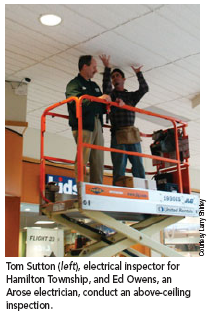 Mall security provides sort of an “umbrella” of protection. The mall is responsible for securing the common, public space, while individual tenants handle their own security. Anchor stores (larger retailers that draw shoppers to the mall) often have elaborate security systems that conform to corporate loss prevention guidelines, with smaller stores running the gamut from locking gates to sophisticated systems of their own.
Mall security provides sort of an “umbrella” of protection. The mall is responsible for securing the common, public space, while individual tenants handle their own security. Anchor stores (larger retailers that draw shoppers to the mall) often have elaborate security systems that conform to corporate loss prevention guidelines, with smaller stores running the gamut from locking gates to sophisticated systems of their own.
Defining this umbrella can be tricky. By nature, shopping malls encompass a lot of physical space and there are lots of entry points, some used considerably less frequently than others. There is essentially a back of house labyrinth of corridors that allow retail goods to be transported from the loading dock to each store without being seen by the public.
At any given time there are one or more stores undergoing renovation that necessitate access by workers after hours. And there are a number of electrical and mechanical rooms that must be secured and protected from vandalism, or worse.
Hamilton Mall, a 1 million-square-foot complex in Mays Landing, N.J., 12 miles outside Atlantic City, recently addressed these needs and challenges.
“Safety is the overriding concern,” explains Bill Schu, general manager for Hamilton Mall. “We had been planning on installing video surveillance and alarm point monitoring for some time, but wanted to do it right. It had to enhance the effectiveness of our security team without becoming intrusive to our guests.”
That basic premise would serve as the foundation for the design, planning and execution of a comprehensive video surveillance solution based on a blend of established and newer technology — and do so for less than originally projected.
Past Experience Pays Off
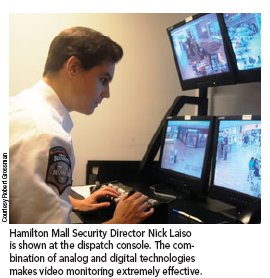 Hamilton Mall is a joint partnership with Simon Properties Group, the largest mall operator in the country, and Kravco Simon Co., a regional mall operator. Our firm had previously done work for King of Prussia Mall, in King of Prussia, Pa., another Kravco Simon property and one of the world’s largest malls (3 million square feet of retail space).
Hamilton Mall is a joint partnership with Simon Properties Group, the largest mall operator in the country, and Kravco Simon Co., a regional mall operator. Our firm had previously done work for King of Prussia Mall, in King of Prussia, Pa., another Kravco Simon property and one of the world’s largest malls (3 million square feet of retail space).
“We take our responsibility for the safety of our customers and the overall property at King of Prussia very seriously and we have invested in both the technology and the people to do that,” says Robert Hart, general manager of the King of Prussia Mall. “One of our primary roles is to protect unauthorized access to the mall after hours. Individual retailers within the mall then further secure their own space in ways that are appropriate to their own needs.”
So we were very familiar with the particular needs of retail shopping malls. At the same time, our experience with gaming-related projects had led us to some innovative features that we tried at King of Prussia and wanted to repeat at Hamilton.
“While our focus is on effective monitoring and protection for the benefit of our customers, tenants and employees, we also need to be mindful of expenditures,” says John Petruzzi, corporate vice president of security for Simon Property Group. “We’re not just buying technology — we’re buying long-term results.”
An Alternative Approach
Armed with an understanding of the unique requirements of shopping malls and a successful installation at a sister property, we sat down with Schu to capture his specific “wish list” of features and functionality. To our surprise, it turned out to be easier than we expected; the mall already had another consultant involved and liked the system that was originally proposed.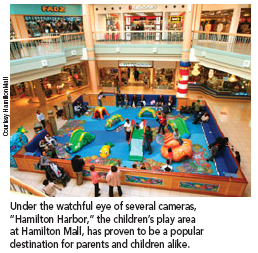
The problem: it was a completely IP-based solution that would break the bank.
“I was looking at having to scale back or defer purchasing, and we knew we needed to get this system installed,” says Schu. “We felt there were too many areas that could invite problems, and while we hadn’t had an incident we didn’t want to wait until something happened to act.”
Our goal was to match the image quality, camera count and feature set of the system that had been previously designed. It had to digitally record images for 30 days, allow for remote monitoring, and include an analog matrix switch for real-time (zero latency) command and control of pan/tilt/zoom (p/t/z) cameras. We were to do this by providing top-quality products from major manufacturers, installed by union labor and warranted for three years from system acceptance.
The reduced price had to include our consulting fees as well and — here’s the challenge — had to cost roughly 30-percent less than the previously designed system to meet budgetary targets. To accomplish this, we knew we’d have to get away from the IP-based design provided by the previous consultant. While the price of IP-based video equipment continues to decline, unfortunately the infrastructure costs do not. For a facility as large as Hamilton Mall, IP-based video meant using fiber-optic cable, while a hybrid system meant copper.
We’d preserve future upgradeability by using Cat-5e instead of coaxial cable, locating data junction boxes in areas where they could be converted to an IP backbone and moving camera power supplies to the data junction areas, but we would have to rely on analog video.
The data junction areas would be run back to the central control area via 25-pair Cat-5 cable, a topology we used with great success on other projects. An added benefit: alarm contacts could be run back in the same manner, further reducing infrastructure costs. Analog cameras would also prove more cost effective than IP-based units as well, particularly p/t/z units. At the time the system was designed, the state-of-the-art optical zoom (35x with image stabilization) was only available in analog, and performance would be better; lower latency on analog camera control meant a more responsive joystick as far as the operator was concerned. Fixed cameras were smaller, less costly and more attractive, and all cameras would be viewable live at 30 images-per-second, with no dropped frames, delayed call-up or compression artifacts.
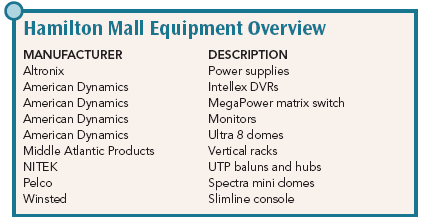
Key Features Prioritized
Once the decision was made to go hybrid, with analog cameras feeding networked DVRs, we started adding back features. Mindful of the budget, we created a specification that included a number of alternates. This would allow us to bid the system to a number of vendors and determine, using actual bid responses, the cost of each feature.
Option packages and enhancements included:
Master evidence server — With the advent of YouTube, an Internet-based repository for amateur videos, there is an ever-increasing need to control security video footage. A centralized, shared hard drive allows any operator to pull a video clip off the DVR and store it on the master evidence server. Without the proper password, the operator can not burn it to a CD or E-mail it to someone, preventing that funny incident in the parking lot from turning into a public relations nightmare.
Part-time p/t/z cameras — By day, when the mall is open, cameras over escalators, elevators and public stairways are fixed on their targets, documenting any “slip-and-fall” incidents for insurance reasons. By providing lower cost dome cameras with limited (8x) optical packages in these positions, we were able to allow the cameras to assist with virtual guard tours during off hours, supplementing the full-performance p/t/z cameras without a major cost impact.
Assignable public view monitors — Since this was a small system, designed for one or two operators, the matrix switch had 16 outputs — 11 more than were needed for control room and office call-up monitors. For the price of some additional monitors, we added outputs in select offices and at the mall information desk, allowing assignable views rather than static displays. A few analog quads (remember them) were fed from matrix outputs and returned through inputs, allowing the viewing of any four cameras at once. Sure, we could do that from the digital workstations, but this low-tech method was more reliable, less costly and tremendously flexible.
Lightning protection — Even though distances did not make it a necessity, all outdoor cameras were to be run using fiber-optic cabling. This optical isolation prevented a strike on an outdoor camera from knocking out any equipment downstream. The mall is on a crest and is the highest point in the area; lightning strikes are inevitable and we wanted to be prepared.
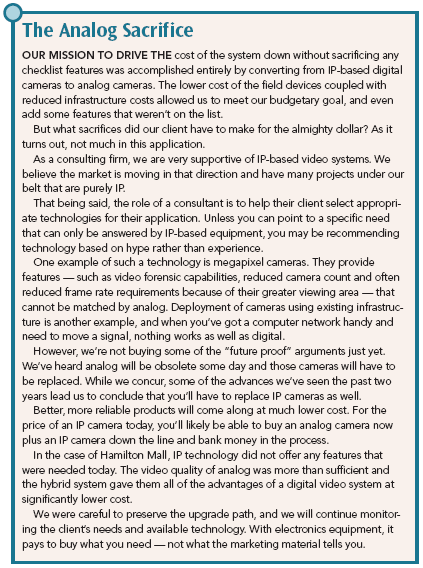
Plan Perfectly Executed
In order to ensure that this project met the cost targets we had imposed on ourselves, planning was critical.
“We’ve had too many projects go over budget because of add-ons and changes, and I didn’t want that to be the case here,” says Schu. “We wanted to know upfront what this would cost — no surprises.” The only way to do that was to carefully document every facet of the system design, allowing the integrator a crystal-clear picture of what it was getting into. We walked the facility several times with Security Director Nick Laiso and Regional Engineering Manager Bill Kirner, and logged every comment. While a few things are always missed, the cost impact on this project was minimal.
The installation went smoothly as well. We had worked before with the integrator selected for the job, Westville, N.J.-based Arose Inc. Project Manager Larry Shirley understood our passion for neat wiring and well-documented installations.
“We always try and get it right the first time,” he says, “but knowing what is expected of you certainly makes that easier to achieve. It was nice having a project that was well planned in advance, and working as a team to make the customer happy instead of doing ‘field engineering.'”
System Benefits Hit Home
Ultimately the system was delivered on budget, with all of the required features and then some. The digital back-end provided by the DVRs will allow a host of additional features, including remote viewing and control, and the ability for an Internet-based “Santa Cam” next holiday season. Camera coverage of the parking lots is better than expected, and the security guards will have to go to the gym more as they tour the mall more with their fingers and less with their feet.
This system’s real benefit, however, hit this author personally. As a consultant used to working on projects around the country, the impact of the system design is rarely personal. But Hamilton Mall is my local mall and, with two teenage children, I appreciate the added sense of safety that this system provides.



